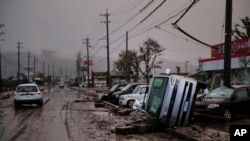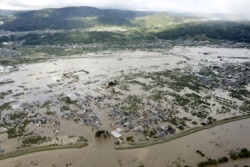Rescue crews in Japan are digging through mudslides and scouring areas near swollen rivers as they look for victims of Typhoon Hagibis, which left dozens of people dead and caused widspread damage in the country's central and northern regions.
The typhoon, which made landfall on Saturday, also caused flooding that left some roads submerged with muddy water. Some homes were inundated with up to three meters of water as Hagibis pounded at least eight prefectures. The storm was reported to have 225 kilometer-per-hour winds.
Authorities said 110,000 rescue workers have been deployed for hurricane relief. The numbers include close to 30,000 members of Japan's Self-Defense Forces.
Separately, reports said a 77-year-old woman plunged 40 meters to her death as she was being placed into a rescue helicopter. Fire department officials apologized and acknowledged the woman had not been secured properly during the airlift, according to NHK.
Ahead of the storm, the government predicted that Hagibis could be the worst typhoon to hit Japan since 1959, when Super Typhoon Vera battered the country, leaving around 5,000 people dead.
In preparation for Hagibis, millions of citizens were urged to evacuate the Tokyo area. The storm also caused the cancelation of several sporting events and widespread power outages.
United Nations Secretary-General António Guterres said he was saddened by reports of loss of life and extension destruction caused by Hagibis. In a statement, Guterres also offered deep condolences to the families of the victims and wished the injured a speedy recovery.
The intense weather event sank a Panamanian cargo ship off Tokyo. Japanese officials say four people were rescued, but that five people on board were killed. Three others remain missing.












